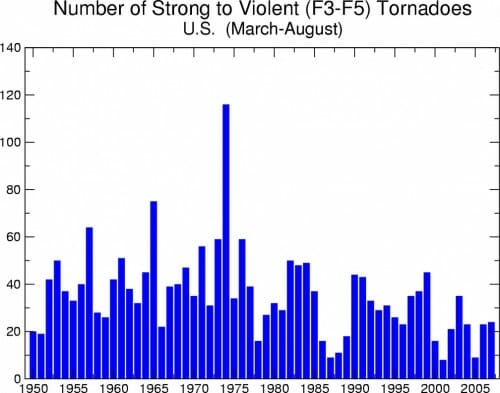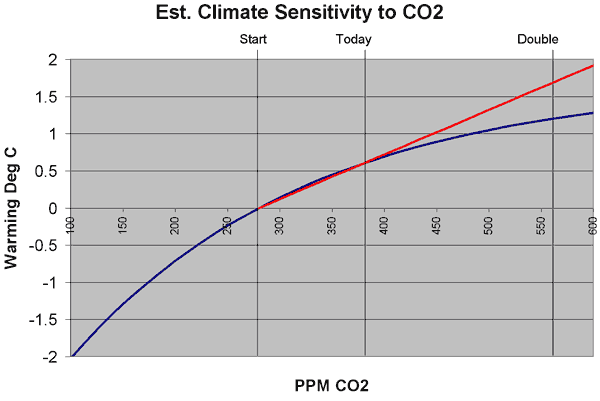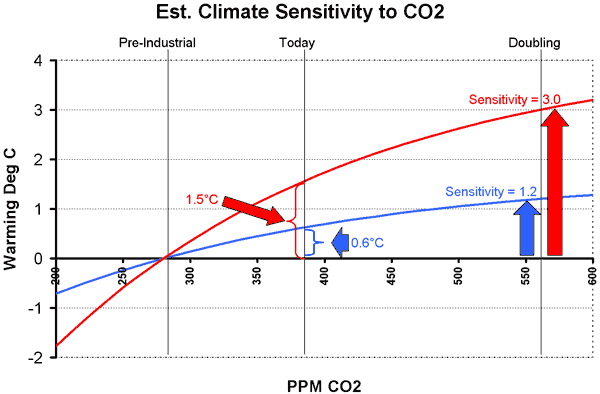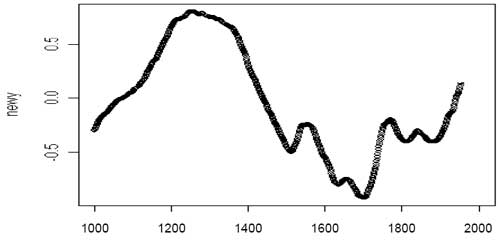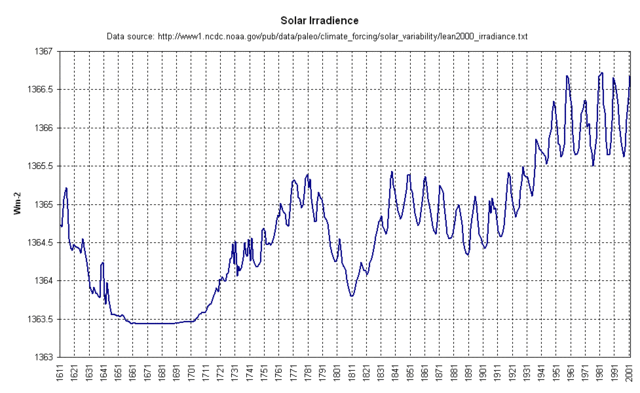The table of contents for the rest of this paper, . 4A Layman's Guide to Anthropogenic Global Warming (AGW) is here. Free pdf of this Climate Skepticism paper is here and print version is sold at cost here
For the first time since the Catholic Church
dominated western man's affairs, it has suddenly become a sin again to be
labeled a "skeptic." For most of my lifetime, "skepticism" was considered
an essential element in the makeup of any good scientist (or journalist, for
that matter). However, leading world figures are declaring
skepticism to be immoral. Take one example, from this UPI
story:
A former chief of the U.N. World
Health Organization who also is a former prime minister of Norway and a medical
doctor has declared an end to the climate-change debate.
Dr. Gro Harlem Brundtland, one of U.N.
Secretary-General Ban Ki-moon's three new special envoys on climate change, also headed up the 1987 U.N. World
Commission on Environment and Development where the concept of sustainable
development was first floated.
"This discussion is behind us. It's
over," she told reporters. "The diagnosis is clear, the science is
unequivocal -- it's completely immoral, even, to question now, on the basis of
what we know, the reports that are out, to question the issue and to question
whether we need to move forward at a much stronger pace as humankind to address
the issues."
In its most extreme form, this approach has AGW supporters
labeling skeptics as equivalent to "holocaust deniers" and "tobacco
lawyers." Efforts have been made in several quarters to decertify
climatologists or meteorologists who show any skepticism for AGW theory, making
public adherence to the theory a minimum qualification for publication and
professional standing. Enormous efforts are made to squelch skeptical
speech. Just as one example, the BBC has run a zillion shows and specials
sympathetic to AGW. When Channel 4 ran one single show (called the
"Global Warming Swindle") which outlined parts of the skeptics' position, 37 scientists attempted to have it
suppressed by the government.
This is all the more incredible given that AGW theory has
only really been researched seriously and with any critical mass for about 20
years. Anyone who has studied the history of science will understand what
incredible hubris it is to declare any new scientific theory, particularly one
that concerns the unbelievably chaotic climate, as "done" after just 20 years
work.
Let me give two quick examples of just how unsettled the
science of climate change is. Both of these will be reviewed in more
depth later in this paper, and both analyses figured prominently in the third
IPCC report (2001) as well as Al Gore's An Inconvenient Truth. The
first is a 100,000 year temperature and CO2-level reconstruction from ice-core
data. Anyone who saw Gore's movie will remember the data in one of his
Really Big Charts. And it looks compelling "“ in fact, when I first saw
the chart five years ago, it was compelling to me. It shows CO2 levels
and temperature moving in lock-step for 100,000 years. When CO2 is up,
temperature is up and vice-versa, the clear implication being that CO2 seems to
be a key, maybe the key, driver of climate However, since
that chart was first prepared, laboratory procedure has improved, and
scientists have found (and there is very little disagreement about this, even
among strong AGW supporters) that temperature increases occur on average 800
years before the CO2 starts to increase. Huh. There is a lot
of debate about what this means, but in the last five years, this formerly definitive
analysis is clearly no longer definitive, since it is hard to cause something
after the fact.
The other example is the very famous Mann hockey stick
chart, prominently featured in Gore's movie and a key part of the IPCC report
in 2001. I will go into the details later, but since 2001 this analysis
has been effectively discredited, so much so it was almost entirely missing
from the fourth IPCC report in 2007. In 2003 or so, Al Gore and many AGW
supporters would have called the Mann hockey stick chart the single most
important analysis "proving" AGW, and Gore treated it as such in his PowerPoint
deck and his movie. Then, in 2007, it is repudiated and expunged from the
record. Is this really what any reasonable person would call a "settled"
science?
It is a true perversion of the scientific process to find
that skepticism is no longer welcome or accepted in scientific debate.
Which is one reason that AGW is sometimes called a secular religion.
Because it is religion, not science, that burns skeptics at the stake. Climate
Scientists Garth Paltridge wrote:
A colleague of mine put it rather
well. The IPCC, he said, has developed a highly successful immune system. Its
climate scientists have become the equivalent of white blood cells which rush
in overwhelming numbers to repel infection by ideas and results which do not
support the basic thesis that global warming is perhaps the greatest of the
modern threats to mankind.
A funny thing has happened in climate science to scientific inquiry:
the usual ethics of free discussion and fact-based criticism have been
discarded in favor of ad hominem attacks on critics of AGW theory.
The usual approach is to find some connection (even an imagined one) between
any researcher who raises the smallest doubts about AGW theory and an oil or
power company and then declare that the research is tainted by the bias of
these companies that have a strong economic reliance on fossil fuel combustion
(and thus the production of CO2). A good example can be found in a Boston
Globe article on MIT's Alfred P. Sloan professor of meteorology Richard
Lindzen. Mr. Lindzen has become the bete noir of AGW supporters,
since his skepticism is harder to dismiss given his scientific pedigree and his
co-lead author status on the first IPCC climate change report.
"We do not understand the natural internal
variability of climate change" is one of Lindzen's many heresies, along
with such zingers as `"the Arctic was as warm or warmer in 1940,"
"the evidence so far suggests that the Greenland ice sheet is actually
growing on average," and "Alpine glaciers have been retreating since
the early 19th century, and were advancing for several centuries before that.
Since about 1970, many of the glaciers have stopped retreating and some are now
advancing again. And, frankly, we don't know why."
When Lindzen published similar views in The Wall
Street Journal this spring, environmentalist Laurie David, the wife of comedian
Larry David, immediately branded him a "shill." She resurrected a
shopworn slur first directed against Lindzen by former Globe writer Ross
Gelbspan, who called Lindzen a "hood ornament" for the fossil fuels
industry in a 1995 article in Harper's Magazine....
For no apparent reason, the state of California,
Environmental Defense, and the Natural Resources Defense Council have dragged
Lindzen and about 15 other global- warming skeptics into a lawsuit over auto-
emissions standards. California et al. have asked the auto companies to cough
up any and all communications they have had with Lindzen and his colleagues,
whose research has been cited in court documents.
"We know that General Motors has been paying
for this fake science exactly as the tobacco companies did," says ED
attorney Jim Marston. If Marston has a scintilla of evidence that Lindzen has
been trafficking in fake science, he should present it to the MIT provost's
office. Otherwise, he should shut up.
"This is the criminalization of opposition to
global warming," says Lindzen, who adds he has never communicated with the
auto companies involved in the lawsuit.
While I have no doubt that corporations are heavily
influenced by their own economic interests, it is more of stretch to argue that
anyone who has ever taken money from them or had any connection with them would
purposely bias their research. When I learned to debate, I was taught
that understanding biases was useful in knowing when to apply more or less
skepticism, but one still has to refute the opposing position by meaningful
critique of procedures or data. For example, one might say "given
their strong desire to buttress the case for AGW, the researchers cherry-picked
only the most extreme data, which I will demonstrate by showing the data they
included and the data they chose to exclude." However, many modern AGW
supporters believe that insinuating possible sources of bias is sufficient to
exempt one from having to actually critique their opponents' methods and
findings.
This is particularly odd given that public funding for AGW
projects absolutely dwarfs any funding coming from private sources whose
incentive might be to disprove AGW. In fact, just this year, President
Bush declared that the US Government alone spent more money on AGW research
than on AIDS research, and the US is actually late in the climate funding
game.
Recently, Greenpeace criticized ExxonMobil for exercising
its free speech rights and giving
about $2 million to global warming skeptics.
Still, the Greenpeace report is already receiving
scrutiny in Washington, where Rep. Brad Miller, a North Carolina Democrat, has
joined the environmentalist group in calling for Exxon to release its plans for
contributions during the current year.
"The support of climate skeptics, many of whom
have no real grounding in climate science, appears to be an effort to distort
public discussion about global warming," Miller said. "So long as
popular discussion could be about whether warming was occurring or not, so long
as doubt was widespread, consensus for action could be postponed."
Incredibly, at these spending rates, skeptics are getting outspent by AGW
supporters something like 1000:1 or more. It is astounding that AGW
supporters, with such a huge funding and publication advantage, still feel
threatened by critics.
Climate research, once a sleepy academic backwater, is now a
multi-billion dollar industry. This boom in spending is because of fears
of AGW, and should AGW theory be discredited, this funding will quickly dry
up. So funding for climate researchers exists only as long as climate
researchers beat the drum that AGW is a large threat. It strikes me
that this is at least as large an incentive for bias as that of any
Exxon-funded skeptic. Here's another way to look at it: If
AGW theory is proven correct, the likely political response might cut Shell's
revenues by 20-30%, at most. If AGW theory is proven incorrect, then
university climate research funding might be cut by 100%.
Directionally, all the incentives in academia are to inflate global
warming projections. No one is going to make the news, or even continue
to get funding, if they argue that warming will only be a degree or two in the
next century. The guys that get the fame and the grants are those pushing
the numbers higher and higher.
Certainly AGW supporters claim that academic researchers are
only concerned about the science and are not concerned about the funding
incentives. This may be true (though a bit naïve, for anyone who has been
in a university environment and sought research funding), but if pro-AGW
researchers are not swayed by the funding, then it should be equally true that
AGW skeptics are not swayed by much smaller amounts of money flowing to
them. Any argument that tries to claim that these situations
are somehow different just ends up being circular, i.e. "it's OK if our guys do
it because our guys are right."
One of the mistakes the IPCC process has systematically made
is to make the lead author's and reviewers of many of its report sections a
scientist whose research is mostly in that area. While this makes a
certain sense, as these people will be expert in their particular area of
review, it presents them with a huge conflict of interest. For example,
Michael Mann used his own historical temperature reconstructions as the lead
analysis in the section of the third IPCC report for which he was lead
author. Clearly, one wouldn't expect him to be (nor was he) open to any
research or issues or criticisms aimed at his own work. In the fourth
report, the new lead author who replaced Mann on this section (Biffra) did the
exact same thing Mann did "“ used his own work as centerpiece of the section,
and has refused to even consider criticisms about that work.
Just to avoid future argument, I
will outline my potential biases. I own a small recreation business which
depends on people traveling to beautiful, natural settings. I lose
business when the climate changes (e.g. when lakes dry up next to my
facilities, which has happened to me). I generally gain business when gas
prices increase, as they might under various anti-global warming mandates,
since my facilities tend to be short-drive weekend destinations rather than cross-country
destinations. I grew up in Houston, Texas, so most of my family has
worked in the oil industry at one time or another, and I worked for the Great
Satan Exxon as my first job for three years out of college. I am a
libertarian blogger at CoyoteBlog.com, and am suspicious of government
interventions but have historically supported emissions limits where they make
sense. No one has contributed any money to me for this paper or for the
operation of my blog.
The Climate Trojan
Horse
To fully understand the passionate, almost dogmatic
dedication so many people have to AGW theory, it is a bit useful to look at a
little history. After the fall of the Soviet Union in 1989, there were a
lot of Marxists, socialists, anti-corporatists and anti-capitalists who were
looking for a new way to package and reinvent themselves, given that the vast
majority of people (at least in the West) considered socialism failed and no
longer wanted to hear about it any more. For a while, many of these folks
latched onto the anti-globalization cause. Every interview I ever saw of
one of these anti-globalization guys was a real mess of disorganized beliefs,
but one could tell the movement was the new home for anyone who wanted to stop
the spread of capitalism and privately-owned business.
Then, along came anthropogenic global warming. Here
was a theory and movement that united many disparate interests:
- Socialists, communists, and Marxists
- Anti-capitalists
- Anti-consumerists
- Those opposed to large corporations
- Those opposed to global free trade
- Those opposed to economic development and growth, longing
for simplicity
- "Buy local" movements
- People who just hate oil companies
Suddenly, here was a big tent for all of these causes.
I highly encourage you to view a global warming rally. Don't just watch
the snippets on the evening news, those usually highlight the most reasonable
speakers at the rally. Actually go and watch the whole event. What
you will see is far more anti-corporate, anti-oil company, anti-capitalist
rhetoric than you will hear climate science and discussion. The two
rallies I have seen with my own eyes were Marxist rallies under a climate
banner. As an admittedly extreme example, I will refer you to the words of
Paul
Watson, Founder and President of Sea Shepherd Conservation Society, who
offers his group's vision. While this particular vision pre-dated most
discussions of AGW, I hope you can see how AGW fear-mongering provides quite a
useful vehicle for groups of this type:
"We need to radically and
intelligently reduce human populations to fewer than one billion.... We need to
stop burning fossil fuels and utilize only wind, water, and solar power with
all generation of power coming from individual or small community units like
windmills, waterwheels, and solar panels. Sea transportation should be by
sail.... Air transportation should be by solar powered blimps when air
transportation is necessary. All consumption should be local. No food products
need to be transported over hundreds of miles to market. All commercial fishing
should be abolished. If local communities need to fish the fish should be
caught individually by hand. Preferably vegan and vegetarian diets can be
adopted.... We need to remove and destroy all fences and barriers that bar
wildlife from moving freely across the land.... We need to stop flying, stop
driving cars, and jetting around on marine recreational vehicles.... Who should
have children? Those who are responsible and completely dedicated to the
responsibility which is actually a very small percentage of humans...."
Of course what he doesn't say, but is an explicit outcome of
this vision, is that we can all go back to being dirt poor and having a life
expectancy of about 40 years.
The average person, say in America, wants little to do with
any of this. But fear of AGW provides a way to engage everyone in the
movement. Socialists of all stripes no longer have to spew Marxist
notions that turn most people off; now, they can talk the science of global
warming and hurricanes and massive floods and such, and, using fear, trample
the average guy into their socialist goals of stifling capitalism, growth, and
having the government take over the economy through this environmental
back-door.
The Need to
Exaggerate
One of the hardest parts of really trying to understand what is going on in
the AGW scientific debate is separating the scientists doing real science from
the political advocates, who sometimes carry quasi-scientific titles. A
very, very small number of vocal climate scientists and a somewhat larger group
of what I would call advocates and bureaucrats really determine what you hear
in the media about AGW science. A great example is the UN IPCC
reports. Unless you have gone online and dug into the detailed reports
themselves, likely all you have seen from these reports is taken out of the
management summaries "for policy-makers". These summaries are written by
bureaucrats and advocates, not so much by scientists, and tend to wildly
mis-characterize the true state of the science. Careful language in
the heart of the reports expressing uncertainty and low understanding of
certain phenomena are cast aside in the summaries, in favor of a comforting
certainty and absolutes. In earlier IPCC reports, this caused notable
disconnects between the summaries and the detailed science. More
recently, the UN has "fixed" this problem by having their non-scientists write the
conclusions in the management summaries first, and then telling authors of the
individual sections of the report to conform their writing, and their science,
to the summary. So, for the Fourth IPCC report, the summary was published
over a half year before the science!
As a result, while the IPCC reports claim to be the consensus of 5000
scientists, actually less than half would willingly sign their name to the
management summaries of their work that you see in the press. The
management summaries and related press releases have become more political
advocacy than science, as UN bureaucrats use AGW-fear-mongering to increase
their prestige and power. Generally, these summaries and press releases
are taken more seriously by the press than they are climate scientists.
You can get an insight on the IPCC process just by looking at how they select
their co-lead authors on certain sections. A logical way to choose these
authors would be to find scientists who bring a different scientific perspective
"“ maybe a leading astronomer who studies the sun, maybe someone who studies
hurricanes, or perhaps even, gasp, a skeptic or two. This is not how the
IPCC makes the selection. Instead, they focus on including scientists,
often with limited experience or expertise, who bring geographic or ethnic
diversity to the panel. Nothing better demonstrates that the IPCC is
first and foremost a political entity, and a scientific body second (at best).
If I seem too hard on the climate science community, then consider this quote
from National Center for Atmospheric Research (NOAA) climate researcher and
global warming action promoter, Steven Schneider:
We have to
offer up scary scenarios, make simplified, dramatic statements, and make little
mention of any doubts we have. Each of us has to decide what the right balance
is between being effective and being honest.
Is that how you learned science in high school "“ that lying
about the science was OK if it makes you more politically effective? Der
Spiegel, a magazine historically sympathetic to the AGW cause, published
this analysis:
This doesn't mean that Gore should necessarily be
taken to task for his statements. He is a politician. But it is odd to hear
IPCC Chairman Pachauri, when asked what he thinks about Gore's film,
responding: "I liked it. It does emotionalize the debate, but it seems
that it has to do that." And when Pachauri comments on the publication of
the first SPM by saying, "I hope that this will shock the governments so
much that they take action," this doesn't exactly allay doubts as to his
objectivity. When Renate Christ, the secretary of the IPCC, is asked about her
opinion of reporting on climate change, she refers to articles that mention
"climate catastrophe" and calls them "rather refreshing." .
. .
The problem is that the IPCC is not a political
group whose goal is to exert pressure, but a scientific institution and panel
of experts. Its members ought to present their results and analyses
dispassionately, the way pathologists or psychiatrists do when serving as
expert witnesses in court, no matter how horrible the victim's injuries and how
deviant the perpetrator's psyche are.
I will end this section on an admittedly extreme example
of a headline taken from the Canadian, a "progressive" magazine up in
the Great White North. In the great race to one-up other media outlets in
creating a panic, and not happy with just a few more hurricanes or some melted
icebergs, the Canadian has taken the prize. Get ready for it"¦
"Over 4.5 Billion people could die
from Global Warming-related causes by 2012"
In case you are struggling with the math, that means that they believe
Global Warming could kill three quarters of the world's population in the next
five years. And the media treats these people with total respect, and we
skeptics are considered loony?
The table of contents for the rest of this paper, . 4A Layman's Guide to Anthropogenic Global Warming (AGW) is here. Free pdf of this Climate Skepticism paper is here and print version is sold at cost here
The open comment thread for this paper can be found here.


